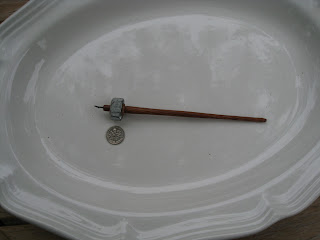What could there be to understanding a simple spindle??? What could I say, that other spinning teachers have not already said? This post is not about basic spinning with a spindle, it is about becoming a very good spindle spinner, quickly!
Spinning is about inserting twist into a fibers. Twist is energy. Inserting twist is physics. A full understanding of spinning includes understanding the physics of the situation well enough to understand why different kinds spindles are better for different kinds of projects. Understaning the physics of spindles will help you choose more functional spindles and help you match the project to the spindle. The right spindle for the project will help you spin faster. The right spindle for the project will help you spin finer. The right spindle for the project will help you avoid overspin! (I am not kidding!) The right spindle will help you spin thicker.
Physics gives us a model so that we can understand what kind of spindles will work better for different kinds of yarns. This means that we do not have to experience every kind of spindle before we can pick the right spindle to spin the knid of yarn that we wish to produce as the next project. This makes learning to spin easier, faster, and cheaper. That is, we do not have to have spun with (own) all kinds spindles to know what spindle is right for the yarn that we want to produce. It takes much of the trial and error out of becoming a very good spindle spinner.
There are a lot different ways to "spin-up" your spindle. Supported spindles want to be "spun-up" one way and top whorl drop spindles want to be spun-up in other ways. Read "Amos" and talk to your spinning teachers. Learn all the ways that your spindles can be spun up.
For a particular spinner at a particular time, a specific spin-up technique will impart a certain amount of energy into the spindle. For now, I am going to call this a "flick", however the energy is delivered to the spindle. That energy will be expressed as rotation, or angular velocity. The speed of rotation will depend on the energy the spinner is able to deliever, the total mass of the spindle, and the distribution of the mass with respect to the axis of rotation.
If the spindle is light in weight (low mass) the spindle will spin faster. If the spindle is heavier, the spindle will spin slower. A flick will cause a supported Russian spindle made from the the local (Russian) pine to spin faster than the replica turned from maple, because the pine spindle is lighter than the maple spindle of the same dimentions. On the otherhand, each spindle contains one flick of energy and will insert the same total number of twists into a thread of the same fiber and grist. However the pine spindle is rotating faster and thus will deliver its twist faster, so that the spinner will need to draft faster when using the lighter pine spindle. The maple spindle will spin slower so the spinner has more time to draft. The faster drafter will have to wait for the slower maple spindle to deliver the twist required to hold the thread together. Where the form factor is the same, the lighter spindle will spin faster (given the same flick). However, the recreational spinner may (very likely) prefer the slower pace of the slightly heavier spindle. Or, a "Russian" spindle turned from basswood, will spin faster than one made from Russian pine because the basswood spindle will be ligher than the pine spindle.
For two spindles of the same mass, the spindle with more of its mass farther from the axis of rotation will spin slower when given one flick of energy. Again the total energy available to insert twist is the same in both spindles. However, the spindle with its mass closer the its axis of rotation (e.g., Russian spindle) will spin faster than a spindle with (some of) its mass farther from its axis of rotation (e.g., a "CD spindle"). Thus, the Russian spindle is more suited to fine grists that require 30 tpi to hold together and the CD spindle is more suited to grists that will hold together with only 4 tpi. Because the Russian spindle is spinning fast, it will deliver its energy and slow down rapidly. Spinning at ~500 rpm the Russian spindle will deliver the twist for 16 inches of thread (at 30 tpi) in about one minute and come to a rest. In contrast, the CD spindle may only be spinning at 50 rpm so that it takes 10 minutes to deliver its energy. Thus, it takes the CD spindle a very long time to twist a fine thread, so people do not use CD spindles for fine spinning, they use them for thicker yarns that require less twist to hold together. These thicker yarns develop more twist rigidity and take more energy to twist, so that for the yarns that CD spindles are used to spin, CD spindles slow down and stop in much less than 10 minutes. However, given the same kind of "flick" a CD spindle and a Russian spindle of the same total mass carry the same energy, but they rotate at different speeds.










.jpg)